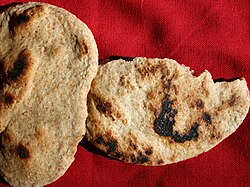Roti pipih
| Roti pipih | |
|---|---|
 Roti pipih buatan rumah | |
| Jenis | Roti |
| Bahan utama | Tepung, air, garam |
Roti pipih adalah sebuah roti yang dibuat dengan tepung, air dan garam, dan kemudian dibentuk menjadi adonan datar. Beberapa roti pipih dibuat tanpa ragi meskipun beberapa menggunakan ragi, seperti roti pita.
Terdapat beberapa bahan opsional lainnya yang dimasukkan dalam roti pipih, seperti bubuk kari, jalapeño, bubuk cabai, atau lada hitam. Minyak zaitun atau biji wijen juga ditambahkan. Roti pipih berukuran tebal dari satu milimeter sampai beberapa sentimeter.
Roti pipih dikenal di Mesir Kuno dan Sumeria. Di Mesopotamia kuno (sekarang Irak), bangsa Sumeria menemukan bahwa biji-bijian pangan dapat ditumbuk menjadi sebuah pasta dan kemudian dipanggang menjadi sebuah roti pipih.

Roti tak beragi (seperti matzoh yang tidak disajikan dengan ragi) biasanya adalah roti pipih dan memegang peran keagamaan istimewa pada pengikut Yudaisme dan Kekristenan.
Ragam roti pipih
[sunting | sunting sumber]Eropa
[sunting | sunting sumber]- Bannock (Skotlandia)
- Bolo do caco (Madeira, Portugal)
- Farl (Irlandia dan Skotlandia)
- Flammkuchen/Tarte flambée (Alsace)
- Flatbrød (Norwegia)
- Flatkaka (Islandia)
- Focaccia (Italia)
- Ftira (Malta)
- Hoggan (Cornwall)
- Lagana (Yunani)
- Lángos (Hungaria)
- Lefse (Norwegia)
- Pane carasau (Sardinia)
- Piadina (Italia)
- Pita (Yunani)
- Pită/Lipie (Rumania)
- Pissaladière (Prancis)
- Pizza (Italia)
- Podpłomyk (Polandia)
- Pogača (Balkan dan Turki)
- Пърленка (Părlenka) (Bulgaria)
- Rieska (Finlandia)
- Sacramental bread (Eropa)
- Shelpek (Asia Tengah)
- Somun dan Lepina (Bosnia dan Herzegovina)
- Spianata sarda (Sardinia)
- Staffordshire oatcake (Inggris)
- Tigella (Italia)
- Torta (Spanyol)
- Torta al testo (Umbria, Italia)
- Torta de Gazpacho (Spanyol)
- Tunnbröd (Swedia)
Timur Tengah dan Afrika
[sunting | sunting sumber]- Roti Afgan atau "Nan" (Afganistan)
- Roti Barbari (Persia)
- Bazlama (Turki): terbuat dari tepung gandum, air minum dan garam
- Bolani (Afganistan)
- Gözleme (Turki)
- Lavash (Armenia)
- Matnakash (Armenia)
- Obi Non (Afganistan dan Uzbekistan)
- Opłatek (Polandia)
- Pide (Turki)
- Sangak (Persia)
- Sheermal (Persia dan anak benua India)
- Shotis Puri (Georgia)
- Roti Taftoon (Persia)
- Tandoor-nan (Asia Tengah)
- Tonis Puri (Georgia)
- Yufka (Turki)
- Aish Merahrah (Mesir)
- Barbari (Iran)
- Gurassa (Sudan)
- Harsha (Maroko)
- Injera (Tanduk Afrika)
- Khebz (Levant)
- Khobz rmal (Maghreb)
- Khubz (Semenanjung Arab)
- Lahoh (Somalia Utara, Djibouti, Yemen)
- Muufo (Somalia)
- Malooga (Yemen)
- Mlawi (Tunisia)
- Chapati (pesisir Swahili, Uganda)
- Markook (Levant)
- Matzo (Israel)
- Murr (Israel)
- Ngome (Mali)
- Pita (Mediterania timur dan Timur Tengah)
- Sangak (Iran)
- Taftan (Iran)
Asia Selatan dan Timur
[sunting | sunting sumber]- Bhakri (India)
- Bhatura (India)
- Bindaeddeok (Korea)
- Bing (Tiongkok)
- Piaya (Filipina)
- Bánh (Vietnam)
- Chapati (India, Pakistan)
- Poli (India)
- Phulka (India, Pakistan)
- Cōng yóu bǐng (Tiongkok)
- Paratha (India, Pakistan, Sri Lanka, Nepal)
- Khanom buang (Thailand)
- Laobing (Tiongkok)
- Naan Keju (Pakistan)
- Naan/Paratha Nutella (Pakistan)
- Luchi (India Timur dan Bangladesh)
- Naan (Pakistan, Asia Selatan, Asia Tengah)
- Pol roti (Sri Lanka)
- Puri (India, Pakistan, Nepal)
- Roast paan (Sri Lanka)
- Roti (Pakistan, Asia Selatan, Asia Tengah)
- Roti prata (Singapura)
- Roti canai (Malaysia dan Indonesia)
- Sanchuisanda (Tiongkok)[1]
Amerika
[sunting | sunting sumber]- Arepa (Kolombia, Venezuela)
- Bammy (Jamaika)
- Beiju (Brasil)
- Casabe (Amerika Selatan, Karibia)
- Frybread (Amerika Serikat)
- Pan de Semita (Meksiko)
- Johnnycake (Karibia)
- Tortilla (Meksiko, Amerika Tengah, Amerika Selatan)
- Tortilla de Rescoldo (Chile)
Catatan kaki
[sunting | sunting sumber]- ^ Sanchuisanda is described in "Peoples of China's Far Provinces", by Wong How-Man, National Geographic, Maret 1984.
Bacaan tambahan
[sunting | sunting sumber]- 2005. "High-Profile Flatbreads - Say Goodbye to Insipid White Bread When Tortillas and Flatbreads Come to Town". FOOD PRODUCT DESIGN -NORTHBROOK-. 15, no. 1: 96-114. ISSN 1065-772X.
- 2008. "Flatbreads Old World: Meets New Flatbreads from All Over the World-Including Tortillas, Arepas and Naan-Are the Newest Hot Ticket in Both Retail and Foodservice Products". FOOD PRODUCT DESIGN -NORTHBROOK-. 18, no. 11: 38-43.
- 2008. "Storied Breads: With a Continuing Focus on Food Origin, Flatbreads Offer Manufacturers a Way to Tempt Consumers with Authentic Products Celebrating the Oldest-Known Bread Traditions". BAKING AND SNACK. 30, no. 7: 35-42. ISSN 1092-0447.
- 2010. "Glycaemic Index of Indian Flatbreads (Rotis) Prepared Using Whole Wheat Flour and Atta Mix-Added Whole Wheat Flour". British Journal of Nutrition. 103, no. 11: 1642-1647. ISSN 0007-1145.
- 2011. "Flat-Out in Love with Flatbread Here Are 5 Reasons Foodservice Is Smitten with Flatbreads". FOOD MANAGEMENT -NEW YORK THEN CLEVELAND OH-. 46, no. 11: 30-35. ISSN 0091-018X.
- Alford, Jeffrey, and Naomi Duguid. Flatbreads and Flavors: A Baker's Atlas. New York: W. Morrow, 1995. Summary: Recipes for more than sixty varieties of flatbreads along with 150 recipes for traditional accompaniments to the breads, including chutneys, curries, salsas, stews, mezze, smorgasbord, kebabs, etc.
- Craddock, Anne. Textural Characteristics of Bagels and Ethnic Flatbreads. 1998. Thesis. 124 leaves.
- German, Donna Rathmell. Flatbreads from Around the World. San Leandro, Calif: Bristol Pub, 1994.
- Hansen, Eric. 2015. "Fabled Flatbreads of Uzbekistan." Diarsipkan 2015-07-21 di Wayback Machine. Aramco World. July/August 2015. Pages 32–39.
- Helou, Anissa. Savory Baking from the Mediterranean: Focaccias, Flatbreads, Rusks, Tarts, and Other Breads. New York: William Morrow, 2007.
- Kahlon, Talwinder Singh, and Mei-Chen Maggie Chiu. 2014. "Ancient Whole Grain Gluten-Free Flatbreads". Food and Nutrition Sciences. 05, no. 17: 1717-1724.
- Khawaja K.I., et al. 2012. "Glycaemic, Insulin and Ghrelin Responses to Traditional South Asian Flatbreads in Diabetic and Healthy Subjects". British Journal of Nutrition. 108, no. 10: 1810-1817.
- Reinhold, John G., Bahram Faraji, Parichehr Abadi, and Faramarz Ismail‐Beigi. 1981. "An Extended Study of the Effect of Iranian Village and Urban Flatbreads on the Mineral Balances of Two Men Before and After Supplementation with Vitamin D†". Ecology of Food and Nutrition. 10, no. 3: 169-177.


